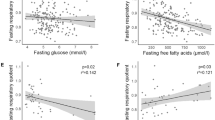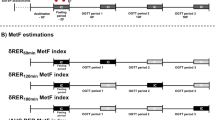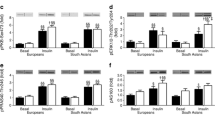Abstract
Purpose
To investigate the association between fasting glucagon-like peptide 1 (GLP-1) levels and resting energy expenditure (REE), and respiratory quotient (RQ) in overweight and obese adults.
Method
Study participants were enrolled at the Dietetic and Metabolic Unit, University of Pavia, Italy. Inclusion criteria were age ≥ 25 and ≤ 45 years, and body mass index (BMI) ≥ 25 and ≤ 35 kg/m2. Diabetic subjects were excluded. Body composition was measured by dual-energy X-ray absorptiometry. REE was evaluated using indirect calorimetry, and RQ was calculated from respiratory gas exchanges. Fasting GLP-1, glucose, insulin and free fatty acid (FFA) levels, and 24-h norepinephrine urinary excretion were measured. Homeostasis model assessments of insulin resistance (HOMA-IR) and beta-cell function (HOMA-β) were calculated.
Results
Thirty-seven participants were included (age 43.4 ± 1.6 years; BMI 30.6 ± 0.5 kg/m2). REE was not associated with fasting GLP-1 levels (p = 0.98) after adjustment for age, sex, fat-free mass (FFM), and fat mass (FM). Similarly, no association was observed between RQ and GLP-1 levels (p = 0.95), after adjustment for age, sex, and body fat.
Conclusion
In adults subjects with increased adiposity fasting, GLP-1 levels do not seem to play a role in the regulation of energy metabolism and in fuel selection.


Similar content being viewed by others
References
Madsbad S (2014) The role of glucagon-like peptide-1 impairment in obesity and potential therapeutic implications. Diabetes Obes Metab 16:9–21
Katsurada K, Yada T (2016) Neural effects of gut- and brain-derived glucagon-like peptide-1 and its receptor agonist. J Diabetes Investig. 7:64–69
Reimann F, Gribble FM (2016) Mechanisms underlying glucose-dependent insulinotropic polypeptide and glucagon-like peptide-1 secretion. J Diabetes Investig. 7:13–19
Sun F, Chai S, Li L, Yu K, Yang Z, Wu S, Zhang Y, Ji L, Zhan S (2015) Effects of glucagon-like peptide-1 receptor agonists on weight loss in patients with type 2 diabetes: a systematic review and network meta-analysis. J Diabetes Res. 2015:157201
Lindamood CA, Taylor JR (2015) Emerging new therapies for the treatment of type 2 diabetes mellitus: glucagon-like peptide-1 receptor agonists. Clin Ther 37:483–493
Rondanelli M, Perna S, Astrone P, Grugnetti A, Solerte SB, Guido D (2016) Twenty-four-week effects of liraglutide on body composition, adherence to appetite, and lipid profile in overweight and obese patients with type 2 diabetes mellitus. Patient Prefer Adherence. 10:407–413
Hwa JJ, Ghibaudi L, Williams P, Witten MB, Tedesco R, Strader CD (1998) Differential effects of intracerebroventricular glucagon-like peptide-1 on feeding and energy expenditure regulation. Peptides 19:869–875
Yamamoto H, Lee CE, Marcus JN, Williams TD, Overton JM, Lopez ME, Hollenberg AN, Baggio L, Saper CB, Drucker DJ, Elmquist JK (2002) Glucagon-like peptide-1 receptor stimulation increases blood pressure and heart rate and activates autonomic regulatory neurons. J Clin Invest. 110:43–52
Yamamoto H, Kishi T, Lee CE, Choi BJ, Fang H, Hollenberg AN, Drucker DJ, Elmquist JK (2003) Glucagon-like peptide-1-responsive catecholamine neurons in the area postrema link peripheral glucagon-like peptide-1 with central autonomic control sites. J Neurosci 23:2939–2946
Nelson DL, Gehlert DR (2006) Central nervous system biogenic amine targets for control of appetite and energy expenditure. Endocrine 29:49–60
Sprague JE, Yang X, Sommers J, Gilman TL, Mills EM (2007) Roles of norepinephrine, free Fatty acids, thyroid status, and skeletal muscle uncoupling protein 3 expression in sympathomimetic-induced thermogenesis. J Pharmacol Exp Ther 320:274–280
Rondanelli M, Opizzi A, Perna S, Faliva M, Solerte SB, Fioravanti M, Klersy C, Cava E, Paolini M, Scavone L, Ceccarelli P, Castellaneta E, Savina C, Donini LM (2013) Acute effect on satiety, resting energy expenditure, respiratory quotient, glucagon-like peptide-1, free fatty acids, and glycerol following consumption of a combination of bioactive food ingredients in overweight subjects. J Am Coll Nutr 32:41–49
Compher C, Frankenfield D, Keim N, Roth-Yousey L, Evidence Analysis Working Group (2006) Best practice methods to apply to measurement of resting metabolic rate in adults: a systematic review. J Am Diet Assoc 106:881–903
Weir JB (1949) New methods for calculating metabolic rate with special reference to protein metabolism. J Physiol 109:1–9
Matthews DR, Hosker JP, Rudenski AS, Naylor BA, Treacher DF, Turner RC (1985) Homeostasis model assessment: insulin resistance and beta-cell function from fasting plasma glucose and insulin concentrations in man. Diabetologia 28:412–419
Deurenberg P, Yap M, van Staveren WA (1998) Body mass index and percent body fat: a meta analysis among different ethnic groups. Int J Obes Relat Metab Disord 22:1164–1171
Flint A, Raben A, Rehfeld JF, Holst JJ, Astrup A (2000) The effect of glucagon-like peptide-1 on energy expenditure and substrate metabolism in humans. Int J Obes Relat Metab Disord 24:288–298
Flint A, Raben A, Ersbøll AK, Holst JJ, Astrup A (2001) The effect of physiological levels of glucagon-like peptide-1 on appetite, gastric emptying, energy and substrate metabolism in obesity. Int J Obes Relat Metab Disord 25:781–792
Tan TM, Field BC, McCullough KA, Troke RC, Chambers ES, Salem V, Gonzalez Maffe J, Baynes KC, De Silva A, Viardot A, Alsafi A, Frost GS, Ghatei MA, Bloom SR (2013) Coadministration of glucagon-like peptide-1 during glucagon infusion in humans results in increased energy expenditure and amelioration of hyperglycemia. Diabetes 62:1131–1138
Bagger JI, Holst JJ, Hartmann B, Andersen B, Knop FK, Vilsbøll T (2015) Effect of oxyntomodulin, glucagon, GLP-1, and combined glucagon+ GLP-1 infusion on food intake, appetite, and resting energy expenditure. J Clin Endocrinol Metab 100:4541–4552
Bradley DP, Kulstad R, Racine N, Shenker Y, Meredith M, Schoeller DA (2012) Alterations in energy balance following exenatide administration. Appl Physiol Nutr Metab 37:893–899
van Can J, Sloth B, Jensen CB, Flint A, Blaak EE, Saris WH (2014) Effects of the once-daily GLP-1 analog liraglutide on gastric emptying, glycemic parameters, appetite and energy metabolism in obese, non-diabetic adults. Int J Obes (Lond). 38:784–793
Pannacciulli N, Bunt JC, Koska J, Bogardus C, Krakoff J (2006) Higher fasting plasma concentrations of glucagon-like peptide 1 are associated with higher resting energy expenditure and fat oxidation rates in humans. Am J Clin Nutr 84:556–560
Shalev A, Holst JJ, Keller U (1997) Effects of glucagon-like peptide 1 (7-36 amide) on whole-body protein metabolism in healthy man. Eur J Clin Invest 27:10–16
Kuk JL, Ardern CI (2009) Are metabolically normal but obese individuals at lower risk for all-cause mortality? Diabetes Care. 32:2297–2299
Nauck MA, Heimesaat MM, Behle K, Holst JJ, Nauck MS, Ritzel R, Hüfner M, Schmiegel WH (2002) Effects of glucagon-like peptide 1 on counterregulatory hormone responses, cognitive functions, and insulin secretion during hyperinsulinemic, stepped hypoglycemic clamp experiments in healthy volunteers. J Clin Endocrinol Metab 87:1239–1246
Macdonald IA (1995) Advances in our understanding of the role of the sympathetic nervous system in obesity. Int J Obes Relat Metab Disord 19:S2–S7
Piaggi P, Vinales KL, Basolo A, Santini F, Krakoff J (2017) Energy expenditure in the etiology of human obesity: spendthrift and thrifty metabolic phenotypes and energy-sensing mechanisms. J Endocrinol Invest. doi:10.1007/s40618-017-0732-9
Tataranni PA, Young JB, Bogardus C, Ravussin E (1997) A low sympathoadrenal activity is associated with body weight gain and development of central adiposity in Pima Indian men. Obes Res 5:341–347
Ranganath LR, Beety JM, Morgan LM, Wright JW, Howland R, Marks V (1996) Attenuated GLP-1 secretion in obesity: cause or consequence? Gut 38:916–919
Ceccarini G, Maffei M, Vitti P, Santini F (2015) Fuel homeostasis and locomotor behavior: role of leptin and melanocortin pathways. J Endocrinol Invest 38:125–131
Author information
Authors and Affiliations
Contributions
EP, LMD, and CC contributed equally to this work; MR and LMD designed the research; SP, MF, and MN performed the research; EP and LP analyzed the data; EP, LMD, CC, and AL wrote the paper. All authors participated in the critical review and in the final approval of the manuscript.
Corresponding author
Ethics declarations
Funding
No funding.
Conflict of interest
All authors declare that they have no conflict of interest.
Ethical approval
All procedures performed in studies involving human participants were in accordance with the ethical standards of the institutional and national research committee and with the 1964 Helsinki declaration and its later amendments or comparable ethical standards.
Informed consent
Informed consent was obtained from all individual participants included in the study.
Rights and permissions
About this article
Cite this article
Poggiogalle, E., Donini, L.M., Chiesa, C. et al. Does endogenous GLP-1 affect resting energy expenditure and fuel selection in overweight and obese adults?. J Endocrinol Invest 41, 439–445 (2018). https://doi.org/10.1007/s40618-017-0764-1
Received:
Accepted:
Published:
Issue Date:
DOI: https://doi.org/10.1007/s40618-017-0764-1




